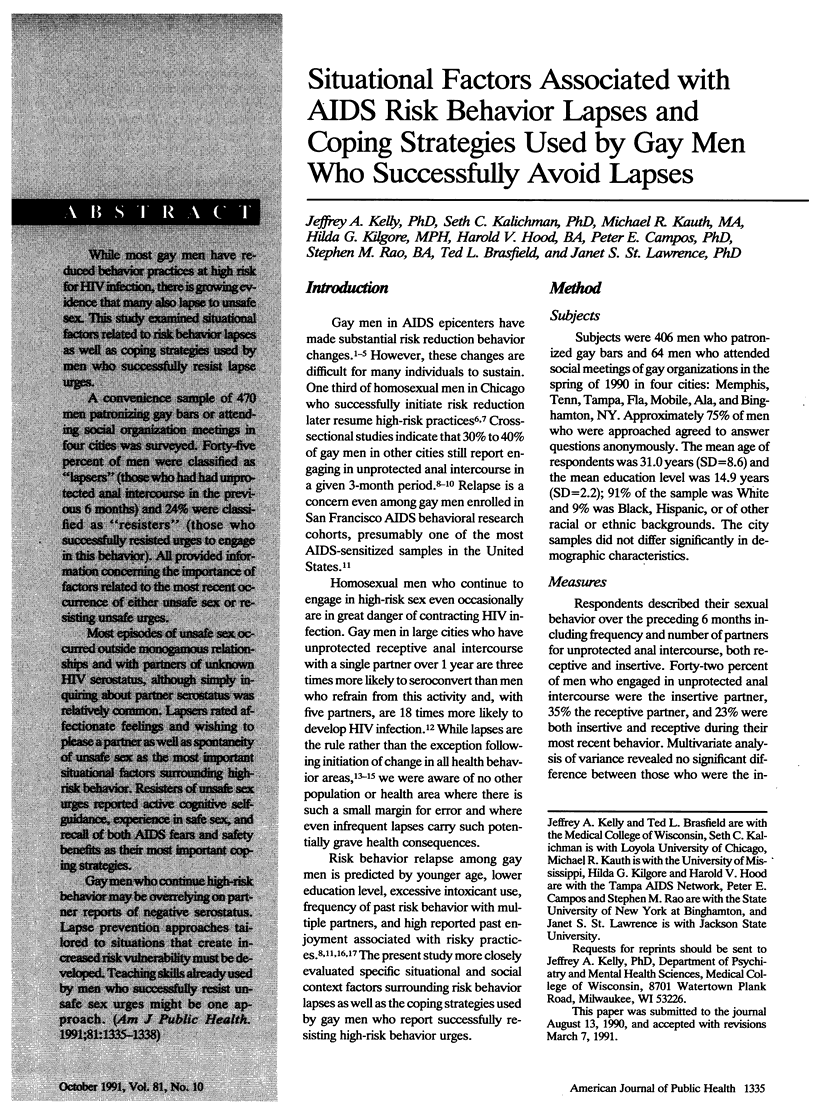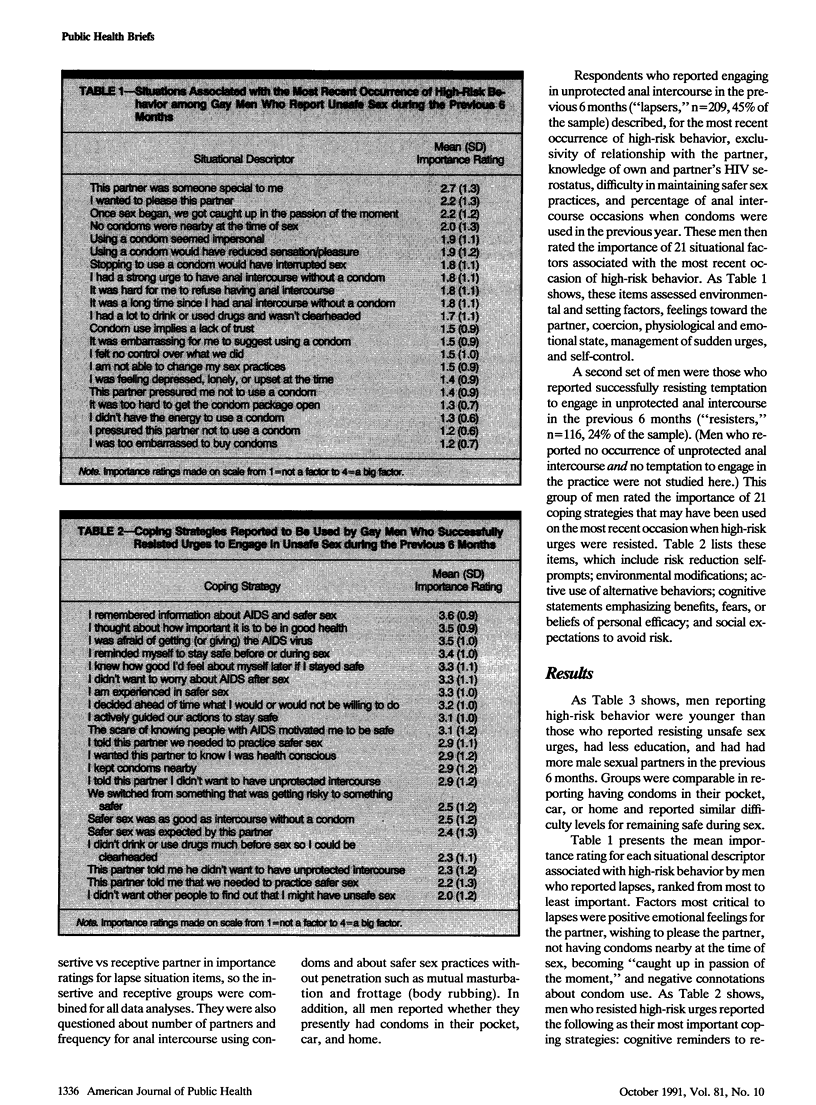Abstract
While most gay men have reduced behavior practices at high risk for HIV infection, there is growing evidence that many also lapse to unsafe sex. This study examined situational factors related to risk behavior lapses as well as coping strategies used by men who successfully resist lapse urges. A convenience sample of 470 men patronizing gay bars or attending social organization meetings in four cities was surveyed. Forty-five percent of men were classified as "lapsers" (those who had had unprotected anal intercourse in the previous 6 months) and 24% were classified as "resisters" (those who successfully resisted urges to engage in this behavior). All provided information concerning the importance of factors related to the most recent occurrence of either unsafe sex or resisting unsafe urges. Most episodes of unsafe sex occurred outside monogamous relationships and with partners of unknown HIV serostatus, although simply inquiring about partner serostatus was relatively common. Lapsers rated affectionate feelings and wishing to please a partner as well as spontaneity of unsafe sex as the most important situational factors surrounding high-risk behavior. Resisters of unsafe sex urges reported active cognitive self-guidance, experience in safe sex, and recall of both AIDS fears and safety benefits as their most important coping strategies. Gay men who continue high-risk behavior may be overrelying on partner reports of negative serostatus. Lapse prevention approaches tailored to situations that create increased risk vulnerability must be developed. Teaching skills already used by men who successfully resist unsafe sex urges might be one approach.
Full text
PDF



Selected References
These references are in PubMed. This may not be the complete list of references from this article.
- Becker M. H., Joseph J. G. AIDS and behavioral change to reduce risk: a review. Am J Public Health. 1988 Apr;78(4):394–410. doi: 10.2105/ajph.78.4.394. [DOI] [PMC free article] [PubMed] [Google Scholar]
- Ekstrand M. L., Coates T. J. Maintenance of safer sexual behaviors and predictors of risky sex: the San Francisco Men's Health Study. Am J Public Health. 1990 Aug;80(8):973–977. doi: 10.2105/ajph.80.8.973. [DOI] [PMC free article] [PubMed] [Google Scholar]
- Hunt W. A., Matarazzo J. D. Three years later: recent developments in the experimental modification of smoking behavior. J Abnorm Psychol. 1973 Apr;81(2):107–114. doi: 10.1037/h0034553. [DOI] [PubMed] [Google Scholar]
- Kelly J. A., St Lawrence J. S., Brasfield T. L., Lemke A., Amidei T., Roffman R. E., Hood H. V., Smith J. E., Kilgore H., McNeill C., Jr Psychological factors that predict AIDS high-risk versus AIDS precautionary behavior. J Consult Clin Psychol. 1990 Feb;58(1):117–120. doi: 10.1037//0022-006x.58.1.117. [DOI] [PubMed] [Google Scholar]
- Kelly J. A., St Lawrence J. S., Brasfield T. L. Predictors of vulnerability to AIDS risk behavior relapse. J Consult Clin Psychol. 1991 Feb;59(1):163–166. doi: 10.1037//0022-006x.59.1.163. [DOI] [PubMed] [Google Scholar]
- Kelly J. A., St Lawrence J. S., Brasfield T. L., Stevenson L. Y., Diaz Y. E., Hauth A. C. AIDS risk behavior patterns among gay men in small southern cities. Am J Public Health. 1990 Apr;80(4):416–418. doi: 10.2105/ajph.80.4.416. [DOI] [PMC free article] [PubMed] [Google Scholar]
- Kingsley L. A., Detels R., Kaslow R., Polk B. F., Rinaldo C. R., Jr, Chmiel J., Detre K., Kelsey S. F., Odaka N., Ostrow D. Risk factors for seroconversion to human immunodeficiency virus among male homosexuals. Results from the Multicenter AIDS Cohort Study. Lancet. 1987 Feb 14;1(8529):345–349. doi: 10.1016/s0140-6736(87)91725-9. [DOI] [PubMed] [Google Scholar]
- Martin J. L., Garcia M. A., Beatrice S. T. Sexual behavior changes and HIV antibody in a cohort of New York City gay men. Am J Public Health. 1989 Apr;79(4):501–503. doi: 10.2105/ajph.79.4.501. [DOI] [PMC free article] [PubMed] [Google Scholar]
- Martin J. L. The impact of AIDS on gay male sexual behavior patterns in New York City. Am J Public Health. 1987 May;77(5):578–581. doi: 10.2105/ajph.77.5.578. [DOI] [PMC free article] [PubMed] [Google Scholar]
- McKusick L., Horstman W., Coates T. J. AIDS and sexual behavior reported by gay men in San Francisco. Am J Public Health. 1985 May;75(5):493–496. doi: 10.2105/ajph.75.5.493. [DOI] [PMC free article] [PubMed] [Google Scholar]
- McKusick L., Wiley J. A., Coates T. J., Stall R., Saika G., Morin S., Charles K., Horstman W., Conant M. A. Reported changes in the sexual behavior of men at risk for AIDS, San Francisco, 1982-84--the AIDS Behavioral Research Project. Public Health Rep. 1985 Nov-Dec;100(6):622–629. [PMC free article] [PubMed] [Google Scholar]
- St Lawrence J. S., Hood H. V., Brasfield T., Kelly J. A. Differences in gay men's AIDS risk knowledge and behavior patterns in high and low AIDS prevalence cities. Public Health Rep. 1989 Jul-Aug;104(4):391–395. [PMC free article] [PubMed] [Google Scholar]
- Stall R., McKusick L., Wiley J., Coates T. J., Ostrow D. G. Alcohol and drug use during sexual activity and compliance with safe sex guidelines for AIDS: the AIDS Behavioral Research Project. Health Educ Q. 1986 Winter;13(4):359–371. doi: 10.1177/109019818601300407. [DOI] [PubMed] [Google Scholar]


